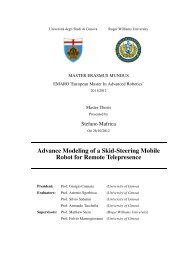SECCM Assessment Plan - Roger Williams University
SECCM Assessment Plan - Roger Williams University
SECCM Assessment Plan - Roger Williams University
You also want an ePaper? Increase the reach of your titles
YUMPU automatically turns print PDFs into web optimized ePapers that Google loves.
Assigning Metrics to Outcomes<br />
The program outcomes are operationalized through a process where faculty members analyze their<br />
courses and assign a measure to the amount of material in the course that corresponds to each<br />
outcome. This process is supported by having each faculty member review a series of<br />
operationalized items associated with each outcome and determining whether certain learning<br />
objectives and competencies associated with the specific outcome are covered. The learning<br />
objectives presented to the faculty in the operationalization process are defined according to Bloom’s<br />
taxonomy and derived from several sources including Bloom et al. (1956) 1 McGourty, Besterfield-<br />
Sarcre and Shuman (1999) 2 and Besterfield-Sarcre et. al (2000), 3 as well as from each faculty<br />
member’s own contributions.<br />
While the process of filling out each form is somewhat time-consuming for each faculty member, it<br />
allows a systematic evaluation of our outcomes that quickly identifies any areas where process<br />
improvement might be implemented. It also allows us to review student material associated with each<br />
outcome to begin the process of determining student competency associated with the outcome. The<br />
initial time for a complete assessment is subsequently recouped by quickly anticipating the impact of<br />
change between a courses and/or outcomes.<br />
Tables 3.12 through 3.12g, show the cover page of the outcomes worksheet and operational<br />
outcomes. This sample is for the course, COMSC 110, Introduction to Computer Science and Lab.<br />
Each faculty member fills out one complete set of these forms for each of a-g outcomes for each of<br />
his or her courses.<br />
1 B. S. Bloom, M. D. Englehart, E. J. Furst, W. H. Hill, and D. R. Krathwohl (1956) Taxonomy of Educational<br />
Objectives: Handbook 1: Cognitive Domain . New York: Longman.<br />
2 J. McGourty, M. Besterfield-Sarcre and L. Shuman (1999) “ABET’s Eleven Student Learning Outcomes: Have<br />
We Considered the Implications” Proceedings of the American Society for Engineering Education National<br />
Conference.<br />
3 M. Besterfield-Sacre, L. Shuman, H., C. Atman, J. McGourty, R. Miller, B. Olds, and G. <strong>Roger</strong>s (2000) “Defining<br />
the Outcomes: A Framework for EC-2000.” IEEE Transactions On Education, Vol. 43, No. 2.<br />
55
















